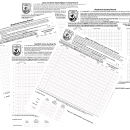What We Do
The Fish and Wildlife Service monitors migratory game bird harvest in the United States. The Branch of Monitoring and Data Management (BMDM) within the Migratory Bird Program uses the Harvest Information Program (HIP) to select hunters for the Migratory Bird Hunter/Harvest Survey (Diary Survey) and the Parts Collection Survey (Wing Survey). All hunters are asked to complete HIP but a smaller sample of hunters are sent the Diary Survey and Parts Collection Survey. The smaller sample is based on HIP responses.
The survey program has three steps:
Step 1-Harvest Information Program (HIP)
All migratory bird hunters are required to fill out HIP when they register for their hunting license. These registration questions include name, address, and hunting activity from the past season. See the Our Laws and Regulations section below for more information.
Step 2-Migratory Bird Hunter Survey (Diary Survey)
We send hunters selected for the Diary Survey a hunting diary form. This form asks for the date, county, and number of birds taken for every hunt. There are five separate surveys for five species or species groups: 1) doves and band-tailed pigeons, 2) waterfowl (ducks, sea ducks, geese, and brant), 3) American woodcock, 4) rails, gallinules, coots, snipe, and 5) sandhill cranes. These surveys are important because they give us harvest estimates for these species/species groups.
Hunters can find the online Diary Survey at https://www.fws.gov/harvestsurvey.
Step 3-Parts Collection Survey (Wing Survey)
To collect information about harvest by species, age, and sex, we conduct Wing Surveys. We select some successful hunters from the Diary Survey and ask them if they are willing to send us parts from the birds that they harvested. Hunters send a wing from each bird they shoot (or tail feather from each goose).
There are three independent wing surveys: (1) waterfowl, (2) mourning dove, and (3) woodcock, rail & band-tailed pigeon.
Biologists at “wingbees” examine wings to determine the birds’ species, age, and sex. Woodcock wings can help us determine their age and sex ratios. Mourning dove and band-tailed pigeon wings can help us determine their age ratios. Rail wings can help us determine their species.
The Diary and Wing Surveys help us estimate how many ducks of different species, ages, and sex were harvested during a hunting season. The surveys also allow us to estimate species and age-specific harvest for geese. We also use age ratios to calculate reproduction rates. Reproduction plays an important role in keeping migratory bird populations stable.
Hunter information is critical to our understanding of migratory bird populations! Annual participation in HIP and the Diary and Wing surveys contributes to wildlife conservation and management.
Our Programs
Our Services
Our Laws and Regulations
If you hunt ducks, coots, geese, brant, swans, doves, woodcock, rails, snipe, sandhill cranes, band-tailed pigeons, or gallinules, you are REQUIRED to participate in the Harvest Information Program (HIP). To comply with HIP, first you must identify yourself as a migratory bird hunter and provide your name, address, and date of birth at the time you purchase your license--something most hunters do already. You must do this in every state in which you hunt migratory game birds.
You will also be asked to voluntarily answer questions about your hunting during last year's season. These questions are not used to make harvest estimates. We ask the states to identify what types of birds you usually hunt so that the USFWS can mail its surveys to the appropriate hunters. For example, we need dove harvest surveys to go to hunters who are likely to hunt doves!
Some states may charge a fee to cover their administrative costs when you register for HIP, but the USFWS will not make any money from the program. HIP is used to gather information and does not raise money for conservation programs.
Lastly, you must have proof of your participation in HIP with you whenever you hunt migratory birds in that state. The state wildlife agency will provide you with a card, stamp, or other proof of participation when you sign up.



